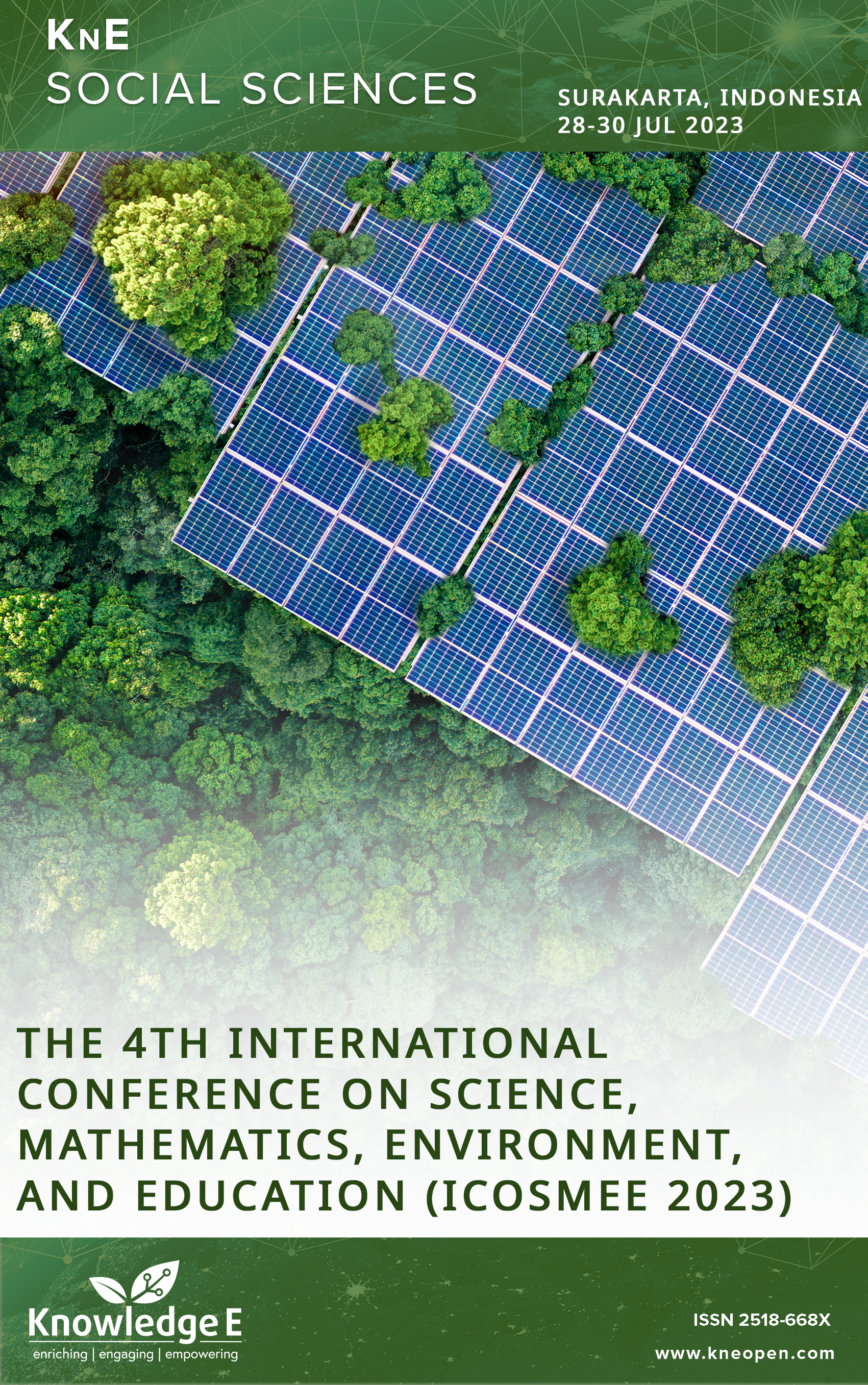Analysis of Epistemological Obstacles on the Material of Two-variable Linear Equation System
DOI:
https://doi.org/10.18502/kss.v10i11.18747Keywords:
epistemological obstacles, mathematic education, two-variable linear equation systemAbstract
Learning barriers can impact teachers and students in achieving learning goals. One such obstacle is epistemological constraints which arise due to limited context provided for a new concept as it is studied for the first time. This study aims to describe students’ epistemological obstacles in learning two-variable linear equation system (SPLDV) using a qualitative method and a phenomenological approach. It involves 12 eighth grade students from Indonesian junior high schools. Data were collected using test methods, observation, and interviews. The validity of the data was established using the triangulation method, requiring the comparison of data with interviews. Data analysis techniques were carried out in three stages of data reduction, data presentation, and conclusions. The results showed four types of epistemological obstacles, namely obstacles in understanding equations, obstacles to algebraic arithmetic operations, barriers to understanding variables, and barriers to making mathematical models. These obstacles cause students difficulty in understanding SPLDV. Therefore, it is important for educators to pay special attention to understanding the basic concepts and requirements in studying SPLDV to help students overcome these obstacles.
References
Acton P. Education for humans. Meanjin. 2016;75(4):106–14.
Chotimah S, Ramdhani FA, Bernard M, Akbar P.) . Pengaruh Pendekatan Model Eliciting Activities Terhadap Kemampuan Komunikasi Matematik Siswa Smp. P2M STKIP Siliwangi. 2019;2(1):40. DOI: https://doi.org/10.22460/p2m.v2i1p40-45.162
Nuraini N, Riadi A, Umanailo MC, Rusdi M, Badu TK, Suryani S, et al. Political policy for the development of education. International Journal of Scientific and Technology Research. 2019;8(11):1871–4.
Gayatri P, Chen S. A Review on Blended Learning for English Language Teaching in Indonesian Higher Education. Sit, Helena H W; 2022. pp. 253–77. DOI: https://doi.org/10.1007/978-981-16-8329-9_14
Oktapiani M, Akbar M, Karnati N. Evaluation of the Implementation of Basic Literacy Education Program in Bogor Regency, Indonesia. J Phys Conf Ser. 2019;1232(1):012032. DOI: https://doi.org/10.1088/1742-6596/1232/1/012032
Lewis BD, Nguyen HT. Assessing the causal impact of compulsory schooling policy in Indonesia. Int J Educ Res. 2020;104:101693. DOI: https://doi.org/10.1016/j.ijer.2020.101693
Simmamora RE, Saragih S, Hasratuddin H. Improving students’ mathematical problem- solving ability and self-efficacy through guided discovery learning in local culture context. International Electronic Journal of Mathematics Education. 2018;14(1):61–72. DOI: https://doi.org/10.12973/iejme/3966
Sutama S, Hartini S, Novitasari M. Kemandirian dalam Pembelajaran Matematika di Madrasah Tsanawiyah. Jurnal VARIDIKA. 2019;30(2):7–14. DOI: https://doi.org/10.23917/varidika.v30i2.7569
How ML. Advancing Multidisciplinary STEM Education with Mathematics for Future Ready Quantum Algorithmic Literacy. Mathematics. 2022;10(7):1146. DOI: https://doi.org/10.3390/math10071146
Fauziyah ME, Hobri MF. Using problem- based learning through blended learning based on JUMPISAproblem against students’ mathematical literacy. Turkish Journal of Computer and Mathematics Education. 2021;12(14):5641–52.
Suryadi D. Landasan filosofis penelitian desain didaktis (DDR). Bandung: Pengem bangan DDR Indonesia; 2019.
Brousseau G. Theory of didactical situations in mathematics. In theory of didactical situations in mathematics. Kluwer Academic Publishers; 2002.
Suryadi D. Pengetahuan transposisi sebagai konektor pendidikan akademik dan pendidikan profesi guru (PPG) matematika. Universitas Pendidikan Indonesia; 2019.
Gradini E. Miskonsepsi Dalam Pembelajaran Matematika. Sekolah Dasar di Dataran Tinggi Gayo. Jurnal Numeracy. 2016;3(2):52–60.
Cornu B. Advanced mathematical thinking, Dordrecht, the Netherlands. “Limits,” in Tall, D. Dordrecht, the Netherlands: Kluwer academic publishers; 1991. 153–166 p.
Santoso T, Nafis NL, OktamaMY.Analyzingstudents’error in problemsolving oftwo variable linear equation system: A case study of grade eight students of Indonesian junior high school. International Journal of Learning. Teaching and Educational Research. 2019;18(11):283–96. DOI: https://doi.org/10.26803/ijlter.18.11.17
Small M. Good questions: great ways to differentiate mathematics, instruction in the standards-based classroom. 2017.
Bakar MT, Suryadi D, Darhim D. Learning obstacles on linear equations concept in junior high school students: analysis of intellectual need of DNR-based instructions. J Phys Conf Ser. 2019;1157(3):17. DOI: https://doi.org/10.1088/1742-6596/1157/3/032104
Modestou M, Gagatsis A. Students’ improper proportional reasoning: A result of the epistemological obstacle of “linearity”. Educ Psychol. 2007;27(1):75–92. DOI: https://doi.org/10.1080/01443410601061462
Perbowo KS, Anjarwati R. Analysis of Students’ Learning Obstacles on Learning Invers Function Material. Infinity Journal. 2017;6(2):169–76. DOI: https://doi.org/10.22460/infinity.v6i2.p169-176
Maarif S, Setiarini RN, Nurafni N. Hambatan Epistimologis Siswa dalam Menyele saikan Masalah Sistem Persamaan Linear Dua Variabel. Jurnal Didaktik Matematika. 2020;7(1):72–89. DOI: https://doi.org/10.24815/jdm.v7i1.15234
Sulastri R, Suryadi D, Prabawanto S, CahyaE.EpistemologicalObstaclesonLimitand Functions Concepts-A Phenomenological Study in Online Learning. Mathematics Teaching-Research Journal. 2022;14(5):84–106.
Ariansyah A, Sugianto S, Bistari B. Mengatasi Hambatan Belajar Dalam Materi Plsv Menggunakan Desain Didaktis Dengan Scaffolding Di Smp. Jurnal lphaEuclidEdu. 2021;2(2):157. https://doi.org/10.26418/ja.v2i2.42869. DOI: https://doi.org/10.26418/ja.v2i2.42869
Maknun CL, Rosjanuardi R, Jupri A. Epistemological Obstacle in Learning Trigonometry. Mathematics Teaching-Research Journal. 2022;14(2):5–25.
LesterS.Anintroductiontophenomenologicalresearch[Internet].Taunton,UK;1999. Available from: www.devmts.org.uk/resmethy.pdf
CreswellJW.Educationalresearch:Planning,conducting,andevaluatingquantitative and qualitative research. Educ Res. 2012.
Fraenkel JR, Wallen NE, Hyun HH. How to design and evaluate re-search in education. 8th ed. New York: Mc Graw Hill; 2012.
Moleong LJ. Metodologi Penelitian Kualitatif [Metodologi Penelitian Kuali tatif]Bandung: Rosdakarya; 2007.
Huberman M, Miles MB. Pendamping Peneliti Kualitatif. 2002.
SuryadiD.DidacticalDesignResearch(DDR)toimprovetheteachingofmathematics. Far East Journal of Mathematics Education. 2013;10(1):91–107.
SommerhoffD,UferS.Acceptancecriteriaforvalidatingmathematicalproofsusedby school students, university students, and mathematicians in the context of teaching. ZDM Math Educ. 2019;51(5):717–30. DOI: https://doi.org/10.1007/s11858-019-01039-7
Rismawati M, Irawan EB, Susanto H. Analisis kesalahan koneksi matematis siswa pada materi sistem persamaan linier dua variabel. In Universitas Muhammadiyah Surakarta; 2016. p. 126–34.
Rasnawati A, Rahmawati W, Akbar P, Putra HD. Analisis kemampuan berfikir kreatif matematis siswa SMK pada materi sistem persamaan linier dua variabel (SPLDV) di kota Cimahi. urnal Cendekia. Jurnal Pendidikan Matematika. 2019;3(1):164–77. DOI: https://doi.org/10.31004/cendekia.v3i1.87
Published
How to Cite
Issue
Section
License
Copyright (c) 2025 Hendri Lutfiatul Hamam Nafis, B Usodo, Siswanto Siswanto, Farida Nurhasanah

This work is licensed under a Creative Commons Attribution 4.0 International License.

